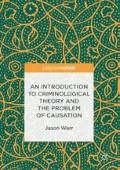Abstract
This chapter explores the relevance of Hume’s analysis and critique of causal explanation to the field of criminological theory. This formulation of causal reasoning, based on an ‘if x then y’ construction, is known as the Humean regularity, or chain, model of causation. It is argued here that this form of reasoning has been implicitly employed throughout the history of the social and criminological sciences. Utilising, and introducing the reader to, an adapted form of symbolic logic this chapter explores, in some depth, the technical and formal structure of the Humean model of causation. Finally, by employing a somewhat simplified example of an imagined Control theory, I show how this model works in terms of the structuring and creation of criminological theory.
Access this chapter
Tax calculation will be finalised at checkout
Purchases are for personal use only
Notes
- 1.
For further details, see Appendix A. For an accessible and complete account of logic see Howson (1997)
- 2.
There are, however, varying interpretations of Hume’s account and not all of them see it as a regularity account. See Hume and Thick Connexions, by Simon Blackburn, references.
- 3.
Of course, this in and of itself is a huge assumption in some criminological theorising. Contraventions of law are widespread and not limited to only a specific subset of the population. It is unlikely that there is anyone in the general population who has not infringed upon the law at some point in their life.
References
Beauchamp, T. L. (1974). Philosophical Problems of Causation. Encino CA: Dickenson.
Beauchamp, T. L. (1999). Introduction. In T. L. Beauchamp (ed.), David Hume: An Enquiry Concerning Human Understanding (pp. 7–61). Oxford University Press.
Beauchamp, T. L. and Rosenberg, A. (1981). Hume and the Problem of Causation. Clarendon: New York and Oxford.
Einstadter, W. J. and Henry, S. (2006). Criminological Theory: An Analysis of it Underlying Assumptions. (2nd edn.). Oxford: Rowman and Littlefield Publishers Inc.
Empiricus, S. (2000). Sextus Empiricus: Outlines of Scepticism. Translated and edited by J. Annas and J. Barnes. Cambridge: Cambridge University Press.
Hirschi, T. (1969). Causes of Delinquency. Berkeley: University of California Press.
Howson, C. (1997). Logic with Trees: An Introduction to Symbolic Logic. London and New York: Routledge.
Hume, D. (1999). An Enquiry Concerning Human Understanding. Tom L. Beauchamp (ed.). Oxford: Oxford University Press.
Hume, D. (2003). A Treatise of Human Nature. J. P. Wright, R. Stecker, and G. Fuller (eds.) London: Everyman Paperbacks.
Jacquette, D. (1993). Logical Dimensions of Question-Begging Argument. American Philosophical Quarterly, 30(4), 317–327.
Marini, M. M. and Singer, B. (1988). Causality in the Social Sciences. Sociological Methodology, 18, 347–409.
Schaffer, J. (2000). Causation by Disconnection. Philosophy of Science, 67(2), 285–300.
Strawson, G. (2014). The Secret Connexion: Causation, Realism and David Hume. (Revised Edn.) Oxford: Oxford University Press.
Suppes, P. (1999). Introduction to Logic. New York: Courier Dover Publications.
Tennant, N. (2005). Rule Circularity and the Justification of Deduction. The Philosophical Quarterly, 55(221), 625–648.
Author information
Authors and Affiliations
Rights and permissions
Copyright information
© 2016 The Author(s)
About this chapter
Cite this chapter
Warr, J. (2016). Humean Causation and Crime Theory. In: An Introduction to Criminological Theory and the Problem of Causation. Palgrave Macmillan, Cham. https://doi.org/10.1007/978-3-319-47446-5_3
Download citation
DOI: https://doi.org/10.1007/978-3-319-47446-5_3
Published:
Publisher Name: Palgrave Macmillan, Cham
Print ISBN: 978-3-319-47445-8
Online ISBN: 978-3-319-47446-5
eBook Packages: Law and CriminologyLaw and Criminology (R0)

